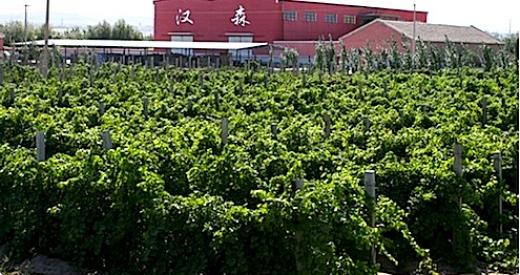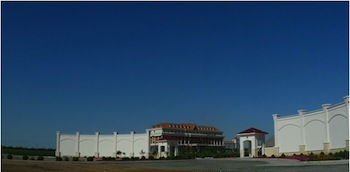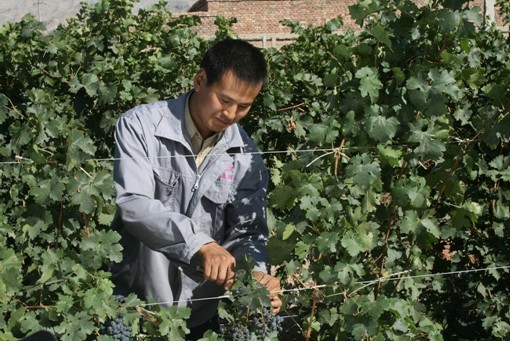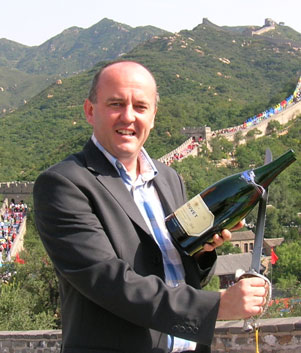
With a staggering 11.6 million hectoliters production in 2011 and thepotential to overtake Australiathis year, China surprises the international wine world with ever-rising production volumes. With quantity comes promising improvements in quality, evidenced by successes in international wine competitions. One highly publicised example is the accolades given to 2009 He Lan Qing Xue Jia Bei Lan from Ningxia which won an International Trophy from Decanter World Wine Awards last year.
Known for its unique nomadic culture and autonomous political status, Inner Mongolia is also recognised as China’s northernmost wine region, producing approximately 41,413 hectolitres in 2011. Making up of a mere 0.4% of China’s 2011 total production volume, this boutique area boasts one of the most sophisticated organic viticulture models in China. Planting theirfirst vines in the early 1980s, Chateau Hansen established their current 250 hectares of vines incorporating organic principles. The owner of Chateau Hansen is Mr. Han Jian Ping, originally a real estate tycoon before he bought Chateau Hansen and serves as Chief Executive of the chateau. Certified by the Chinese government and on its way to obtaining the European “Bio” label, Chateau Hansen is forging its own path to produce organic wines in one of the most challenging climates in the world.

Entrance to Chateau Hansen, Inner Mongolia
Asian Palate talks to Bruno Paumard, winemaker of Chateau Hansen since 2005, who shares his views on how he keeps the vineyard cycle running under harsh climatic conditions including wide diurnal temperature variation and his views on China’s industry and market outlook.
AP: Asian Palate BP: Bruno Paumard
AP: How do you maintain a healthy level of biodiversity in the sandy soil when practicing organic viticulture in Mongolia?
BP: We transformed the Gobi desert into a green vineyard, so I must admit that there is nothing except sand, before we planted the vineyard. Actually, we also do a little bit of biodynamic. In one out of three areas between the vines, we plant some late green herbs and wheat to make a natural compost when we bury the vines in winter to increase resistance to the eventual frost.
AP: Given the large diurnal and seasonal temperature range, how do you keep the vines from shutting off due to coldness or growing too fast due to high desert heat other than performing buttage (hilling) during dormant season?
BP: Yes, we bury the vines between end of November to the 15th of April, just in case the temperature becomes very cold. In 2010 and 2011, we didn’t have especially low temperatures but in 2009, we had a minus 30 degrees Centigrade temperate, and even if the vines were buried, we would have lost a lot of young vines that year. On the other hand, the high temperatures during summer are good for the grapes and makes quick maturation of the colors and tannins in the skin; the natural acidity then stays on a good level!
AP: How is making wines in Inner Mongolia different from your previous experience working as a winemaker in Loire Valley?
BP: Making Merlot, Cabernet Gernischt and Cabernet Sauvignon are nice to work with here because it never rains in September and October, so we have no disease at all in the vineyard! Before I used to have to manage rotten grapes in France but here, it is just like paradise, not rot at all! It is so easy to make organic wines in those conditions.
AP: What are the stylistic or flavour differences between Hansen’s Cabernet Gernischt and Cabernet Sauvignon wines?
BP: On Wuhai’s terrior, the Cabernet Gernischt has a spicy taste with a real aroma of pepper. It is a true terroir effect, because I also make some Cabernet Gernischt in Ningxia, but it is more vegetal than spicy there. Everyone can easily smell the difference. The Cabernet Sauvignon of Wuhai are very concentrated with strong tannins but unfortunately, the fruits in the wine open very late. Our Cabernet Sauvignon of Ningxia open more quickly. It is quite similar with these grapes in the “Graves” and “Saint Estephe” appellations in Bordeaux which are much more north.

Worker at Hansen Winery handpicking grapes during harvest
AP: How are Hansen wine sales and what is the production volume of the latest vintage? Are they still mainly consumed by the Chinese domestic market? How many % of wines are exported since you started the export division – mainly to which countries and via what channels?
BP: From the beginning of 2010 until June 2011, we sold around 2 million bottles and then produced 3 million litres in the vintage 2011. All were sold in the Chinese market, but most notably two-thirds of the sales were in our region, Inner Mongolia, where we are the star brand. Today we export to Denmark, France, Holland, Thailand and Japan but only approximately 2% of the production.
AP: What is your vision for Hansen? What wines from China have you tasted that are, in your opinion, internationally competitive and of high quality? What do you think about the future of winemaking in Inner Mongolia?
BP: Our region is the best terroir of China because it’s not cold as Gansu or Xingjiang but far enough from the sea to have no rain, and thus no disease! We are growing every year at the moment because the consumption of wine is growing in China, and we don’t know when it will stop! More and more Chinese people drink wine instead of baijiu and like it for their ganbei! So we are confident in the future but concerning exports, I am afraid this little beginning we have now will end soon because the value of the RMB is rising little by little and soon Chinese wine will become too expensive to import!

Bruno Paumard, winemaker of Chateau Hansen since 2005
Notes:
Figures on China’s 2011 wine production volume is extracted from Tang Jiu Kuai Xin “Report of China Liquor Trade” released in March 2012.
Latest consolidated figures from National Statistics Bureau of China: Inner Mongolia produces 13,804.2 hectoliters from January to April 2011.









